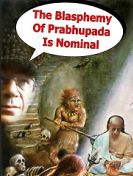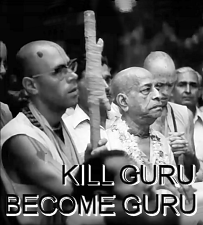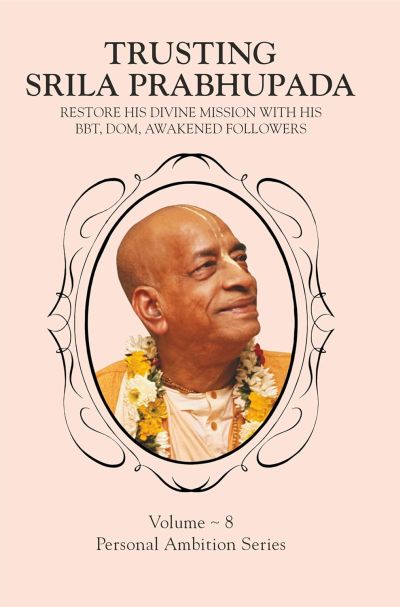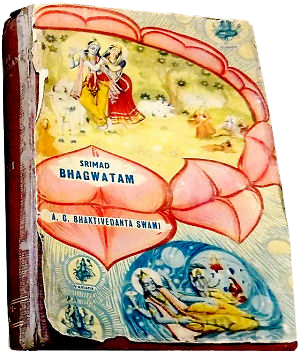httpv://youtu.be/KfugpOnKn9A
video: Ralph Laurino
By Yashoda Nandana Prabhu
Abhirama Dasa Thakura disappearance April 12
Thursday, April 12, 2012 (USA)
Sri Abhirama dasa Thakura disappearance day
Srila Prabhupada explains the glories of Sri Abhirama dasa Thakura
sri-ramadasa ara, gadadhara dasa
caitanya-gosanira bhakta rahe tanra pasa
SYNONYMS
sri-ramadasa—of the name Sri Ramadasa; ara—and; gadadhara dasa—of the name Gadadhara dasa; caitanya-gosanira—of Lord Sri Caitanya Mahaprabhu;bhakta—devotees; rahe—stay; tanra pasa—with Him.
TRANSLATION
Two devotees of Lord Caitanya, named Sri Ramadasa and Gadadhara dasa, always lived with Sri Virabhadra Gosani.
PURPORT
Sri Ramadasa, later known as Abhirama Thakura, was one of the twelve gopalas, cowherd boyfriends, of Sri Nityananda Prabhu.
The Gaura-ganoddesa-dipika, verse 126, states that Sri Ramadasa was formerly Sridama. In Bhakti-ratnakara (Fourth Wave), there is a description of Srila Abhirama Thakura. By the order of Sri Nityananda Prabhu, Abhirama Thakura became a great acarya and preacher of the Caitanya cult of devotional service.
He was a very influential personality, and nondevotees were very afraid of him. Empowered by Sri Nityananda Prabhu, he was always in ecstasy and was extremely kind to all fallen souls. It is said that if he offered obeisances to any stone other than a salagrama-sila, it would immediately fracture.
Ten miles southwest of the Canpadanga railway station on the narrow-gauge railway line from Howrah, in Calcutta, to Amta, a village in the Hugali district, is a small town named Khanakula-krsnanagara, where the temple of Abhirama Thakura is situated.
During the rainy season, when this area is inundated with water, people must go there by another line, which is now called the southeastern railway. On this line there is a station named Kolaghata, from which one has to go by steamer to Ranicaka. Seven and a half miles north of Ranicaka is Khanakula.
The temple of Abhirama Thakura is situated in Krsnanagara, which is near the kula (bank) of the Khana (Dvarakesvara River); therefore this place is celebrated as Khanakula-krsnanagara. Outside of the temple is a bakula tree. This place is known as Siddha-bakula-kunja. It is said that when Abhirama Thakura came there, he sat down under this tree. In Khanakula-krsnanagara there is a big fair held every year in the month of Caitra (March-April) on the Krsna-saptami, the seventh day of the dark moon.
Many hundreds and thousands of people gather for this festival. The temple ofAbhirama Thakura has a very old history. The Deity in the temple is known as Gopinatha. There are many sevaita families living near the temple. It is said thatAbhirama Thakura had a whip and that whoever he touched with it would immediately become an elevated devotee of Krsna. Among his many disciples, Sriman Srinivasa Acarya was the most famous and the most dear, but it is doubtful that he was his initiated disciple
Sri Caitanya-caritamrta – 1975 Edition : Cc. Adi-lila : Adi 11: The Expansions of Lord Nityananda : Adi 11.13 :
TEXT 116
ramadasa abhirama–sakhya-premarasi
solasangera kastha tuli’ ye karila vansi
SYNONYMS
ramadasa abhirama—of the name Ramadasa Abhirama; sakhya-prema—friendship; rasi—great volume; solasa-angera—of sixteen knots; kastha—wood; tuli’-lifting; ye—one who; karila—made; vansi—flute.
TRANSLATION
Ramadasa Abhirama was fully absorbed in the mellow of friendship. He made a flute of a bamboo stick with sixteen knots.
PURPORT
Abhirama was an inhabitant of Khanakula-krsna-nagara. Books : Sri Caitanya-caritamrta – 1975 Edition : Cc. Adi-lila : Adi 10: The Trunk, Branches and Subbranches of the Caitanya Tree : Adi 10.116 :







Speak Your Mind